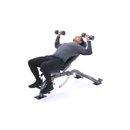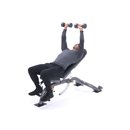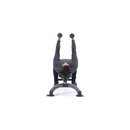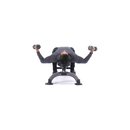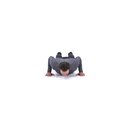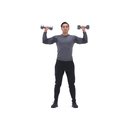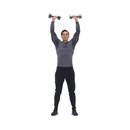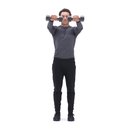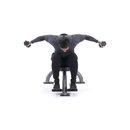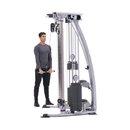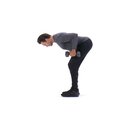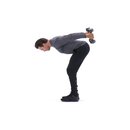12 Week Workout Program
Summer is only weeks away and time is running out to have the body that you want. You want to be noticed at the beach or club,but most of all you will feel good about yourself.
It wont be easy and you will have to stick to the program and EAT HEALTHY.....Training without proper nutrition is just a huge waste of time. I have found a program that seems to work well and outlines everything you need to do all 12 weeks.....Like I said, stick to the program and eat right and I guarantee that you will see results...
In this article I will cover these questions and lay out a 12 week
workout program that you can follow to make some good progress. And
hopefully I will clear up some of the confusion about working out.
There is really no right or wrong way to workout. You could ask 10
different bodybuilders to explain their workout routine and most likely
you would get 10 different answers.
"Everything works, but nothing works forever."
That is probably the most important thing to remember for making
consistent progress with your workouts. You can follow most any type of
workout routine and you will make good progress for the first few weeks
(provided that you are getting adequate nutrition, rest, etc.). But
generally after a few weeks of following a set workout program your
progress will slow down and eventually you will no longer make progress
with that routine.
Our bodies are very smart and naturally
accommodate to stress. Your body will add as little muscle as necessary
to get the job done. This is why construction workers get only big
enough to handle the exact amount of work they do during a days work and
no bigger, even though they are doing physical work all day long.
Adding muscle is a very unnatural thing to your body. You must
constantly throw "curve balls" at your muscles to get them to grow.
Generally, you will make the best progress for the first 3 weeks of starting a new workout routine. After 3 weeks your body starts to adapt and your progress will slow down.
In the following workout routine I have placed 4 different, 3-week
workout cycles back to back in order to make a 12 week workout program.
This program requires you to
workout 4 days per week. Ideally you
would workout on Monday, Tuesday, Thursday, and Friday. And rest on
Wednesday's and weekends. But if this doesn't fit your schedule you can
workout on other days of the week. Just make sure that you do not
workout for more then 2 days in a row before taking a day off.
By doing this you will give your body plenty of time for recuperation and muscle growth.
Muscles do not grow while you are working out; they grow while you are resting.
Working out will stress and damage the muscles slightly. Then your body
reacts by building up the muscles in order to handle the extra work and
stress.
Note:
With each of the exercises do as many warm up sets as you need to get to
your top working weight. Then perform the required sets and reps with
the same weight.
For example:
So let’s just say your top weight for 5 sets of 5 reps is 100 lbs.
- Do one warm up set with 50 lbs.
- Do another warm up with 75 lbs.
- Then go to your top weight of 100 lbs. and perform 5 x 5 with 100 lbs.
If you get all 5 x 5 with good form, then up the weight to 105 lbs. for your next workout and repeat the process.
If you can't get all 5 x 5 or you found them extremely difficult, keep the same weight for your next workout.
The Workout Routine
Click on the exercise name for a picture of the exercise (all pictures open in a new window).
Weeks 1, 2, and 3 do the following workout routine.
Monday: (five minutes of light cardio to warm up)
Squats:
- do a couple warm up sets first
- 5 sets of 5 reps (train heavy, but don't train to failure)
Dead lifts:
- do a couple warm up sets first
- 5 sets of 5 reps (train heavy, but don't train to failure)
Standing calf raise:
- 5 sets of 10 reps
Leg raises:
- 5 sets of 10 reps
Incline sit ups:
- 3 sets of 10-20 reps
Tuesday: (five minutes of light cardio to warm up)
Incline barbell bench press:
- do a couple warm up sets first
- 5 sets of 5 reps (train heavy, but don't train to failure)
Seated dumbbell shoulder press:
- 5 sets of 8 reps
Bicep cable curls: (from low pulley)
- 5 sets of 10 reps
Tricep push downs: (using straight bar attachment)
- 5 sets of 10 reps
Bent over dumbbell lateral raises:
- 3 sets of 10-15 reps
Thursday: (five minutes of light cardio to warm up)
Leg press:
- do a couple warm up sets first
- 4 sets of 15 reps
Leg curls:
- 4 sets of 15 reps
Wide grip pull downs:
- 4 sets of 15 reps
Hyper extensions:
- 4 sets of 10 reps
Pull down ab crunches:
- 4 sets of 15 reps
Friday: (five minutes of light cardio to warm up)
Incline dumbbell bench press:
- do a couple warm up sets first
- 4 sets of 10 reps
Dumbbell side lateral raises:
- 4 sets of 10 reps
Bicep dumbbell curls:
- 4 sets of 12 reps
Tricep push downs: (with rope attachment)
- 4 sets of 12 reps
Barbell upright rows:
- 3 sets of 15 reps
Keep records of the exercises, weights, sets, and reps that you do.
Each workout try to beat what you did for your previous workout. With
the squat, dead lift, and incline barbell bench press try to add 5 lbs.
to the bar each week and do the same number of sets and reps.
Weeks 4, 5, and 6 do the following workout routine.
Monday: (five minutes of light cardio to warm up)
Bent over barbell rows:
- do a couple warm up sets first
- 5 sets of 8 reps
Barbell shoulder shrugs:
- 5 sets of 10 reps
Leg extensions:
- 5 sets of 10 reps
Leg curls:
- 5 sets of 10 reps
Seated calf raise:
- 5 sets of 10 reps
Incline sit ups:
- 3 sets of 10-20 reps
Tuesday: (five minutes of light cardio to warm up)
Decline barbell bench press:
- do a couple warm up sets first
- 5 sets of 5 reps (train heavy, but don't train to failure)
Seated barbell shoulder press: (i.e. military press)
- 5 sets of 8 reps
Preacher barbell curls:
- 5 sets of 10 reps
Lying tricep extensions: (with the EZ bar)
- 5 sets of 10 reps
Cable upright rows: (from the low pulley)
- 3 sets of 15 reps
Thursday: (five minutes of light cardio to warm up)
Hack Squat::
- do a couple warm up sets first
- 4 sets of 15 reps
Stiff leg dead lifts::
- 4 sets of 15 reps
Seated cable rows:
- 4 sets of 15 reps
Leg raises:
- 4 sets of 12 reps
Crunches::
- 4 sets of 25+ reps
Friday: (five minutes of light cardio to warm up)
Flat dumbbell bench press:
- do a couple warm up sets first
- 4 sets of 10 reps
Dumbbell front lateral raises:
- 4 sets of 10 reps
Bicep barbell curls:
- 4 sets of 12 reps
Tricep push downs: (with V bar attachment)
- 4 sets of 12 reps
Close grip pull downs:
- 4 sets of 15 reps
Keep records of the exercises, weights, sets, and reps that you do.
Each workout try to beat what you did for your previous workout. With
the decline bench press and the bent barbell row try to add 5 lbs. to
the bar each week and do the same number of sets and reps.
Weeks 7, 8, and 9 do the following workout routine.
Monday: (five minutes of light cardio to warm up)
Squats:
- do a couple warm up sets first
- 5 sets of 5 reps (train heavy, but don't train to failure)
Partial Dead lifts: (use a power rack and set the bar just below your knees)
- do a couple warm up sets first
- 5 sets of 5 reps (train heavy, but don't train to failure)
Chin ups:
- 4 sets of as many reps as you can do
Pull down ab crunches:
- 5 sets of 10 reps
Leg raises:
- 5 sets of 10 reps
Tuesday: (five minutes of light cardio to warm up)
Flat barbell bench press:
- do a couple warm up sets first
- 5 sets of 5 reps (train heavy, but don't train to failure)
Bent over dumbbell lateral raises:
- 4 sets of 10 reps
Dumbbell side lateral raises:
- 4 sets of 10 reps
Dumbbell front lateral raises:
- 4 sets of 10 reps
Bicep cable curls: (from low pulley)
- 5 sets of 10 reps
Tricep push downs: (using straight bar attachment)
- 5 sets of 10 reps
Thursday: (five minutes of light cardio to warm up)
Hack Squat::
- do a couple warm up sets first
- 5 sets of 10 reps
Leg press:
- 4 sets of 15 reps
Chest supported row: (i.e. T-bar row, hammer strength seated row, etc.)
- 4 sets of 10 reps
Hyper extensions:
- 4 sets of 10 reps
Pull down ab crunches:
- 4 sets of 15 reps
Friday: (five minutes of light cardio to warm up)
Dumbbell bench press on the stability ball:
- do a couple warm up sets first
- 4 sets of 10 reps
Dumbbell shoulder press sitting on the stability ball:
- 4 sets of 10 reps
EZ bar bicep curls:
- 4 sets of 12 reps
One arm over head dumbbell extensions:
- 4 sets of 12 reps
One arm dumbbell rows:
- 3 sets of 15 reps
Keep records of the exercises, weights, sets, and reps that you do.
Each workout try to beat what you did for your previous workout. With
the squat, partial dead lift, and flat barbell bench press try to add 5
lbs. to the bar each week and do the same number of sets and reps.
Weeks 10, 11, and 12 do the following workout routine.
Monday: (five minutes of light cardio to warm up)
Leg press:
- do a couple warm up sets first
- 5 sets of 5 reps (train heavy, but don't train to failure)
Stiff leg dead lifts:
- do a couple warm up sets first
- 5 sets of 5 reps (train heavy, but don't train to failure)
Wide grip pull downs:
- 4 sets of 10 reps
Incline sit ups:
- 5 sets of 15 reps
Leg raises:
- 5 sets of 15 reps
Tuesday: (five minutes of light cardio to warm up)
Dips: (add extra weight if needed)
- do a couple warm up sets first
- 5 sets of 5 reps (train heavy, but don't train to failure)
Chin ups:
- 4 sets of as many reps as you can do
Side lateral raises:
- 4 sets of 10 reps
Seated barbell shoulder press: (i.e. military press)
- 4 sets of 10 reps
Bicep dumbbell preacher curls:
- 5 sets of 10 reps
Tricep push downs: (using rope attachment)
- 5 sets of 10 reps
Thursday: (five minutes of light cardio to warm up)
Squats:
- 4 sets of 15 reps
Leg curls:
- 4 sets of 15 reps
Leg extensions:
- 4 sets of 15 reps
Seated cable rows:
- 4 sets of 10 reps
Standing calf raise:
- 4 sets of 10 reps
Pull down ab crunches:
- 4 sets of 15 reps
Friday: (five minutes of light cardio to warm up)
Push ups with feet elevated on the stability ball:
- 4 sets of as many reps as you can do
Seated dumbbell shoulder press:
- 4 sets of 10 reps
Standing one arm dumbbell curls:
- 4 sets of 12 reps
(Super set the curls with the over head tricep extensions, you can use
the same dumbbell for both exercises. For example, set of curls with
one arm, set of curls with the other arm, set of extensions with one
arm, set of extensions with the other arm, with no rest in between.)
One arm over head dumbbell extensions:
- 4 sets of 12 reps
Close grip pull downs:
- 4 sets of 15 reps
Keep records of the exercises, weights, sets, and reps that you do.
Each workout try to beat what you did for your previous workout. With
the weighted dips and leg press try to add 5 lbs. to the bar each week
and do the same number of sets and reps.
Each 3 week cycle is different. You will focus on different exercises
during each cycle. This will allow you to make consistent progress over
the long term.
After you complete this 12 week workout program you can go through the
program again and strive to beat your personal best lifts from the first
time through. Or you can move on to something totally different.
Special thanks to
Lee Hayward for this great program......

